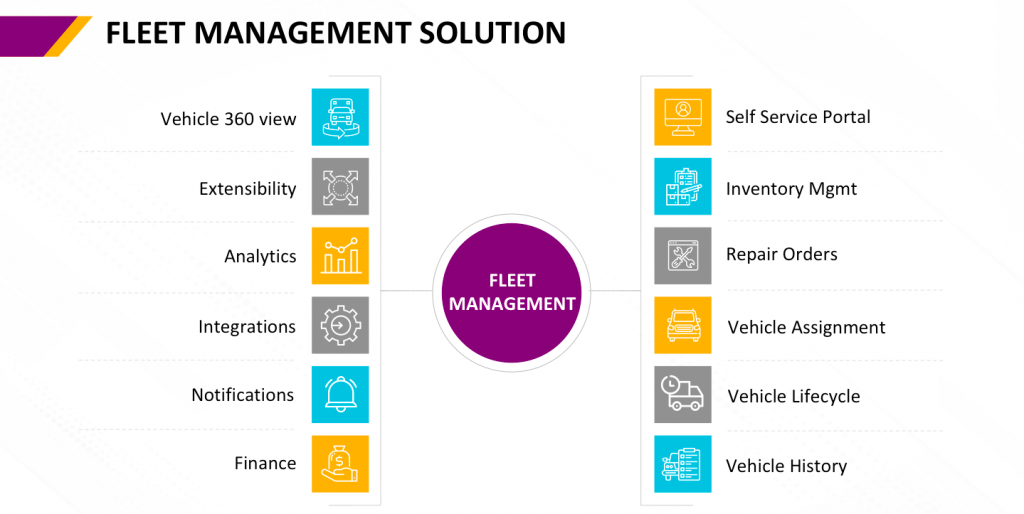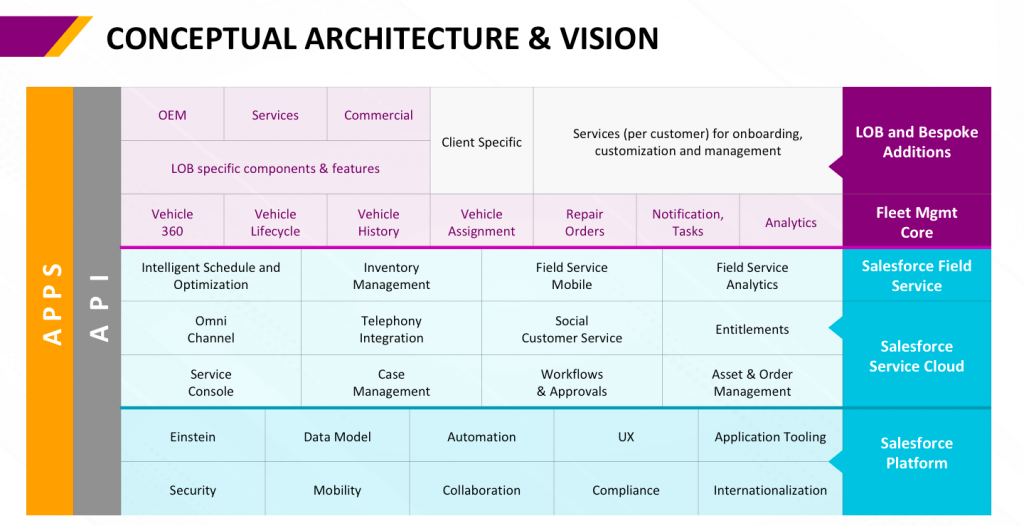- Stronger Customer Relationships
- +1-949-878-7411
- ramana@varasi.com
Salesforce Fleet Management Solution

In our previous blog, we reviewed how the right digital platform is key for operational efficiency and better customer experience in fleet management. In this blog, we deep dive into the Fleet Management Solution. We will go over all the elements of a robust Fleet Management Solution and share our perspective and experience in building such a solution on the Salesforce platform.
An Overview
A complete Fleet Management Solution, if done right, can prove to be a strategic advantage. The solution must be cloud enabled, secure, with mobile first user experience, equipped with data analytics and should be easily integratable with other platforms and partner systems through APIs. To incorporate these aspects, the technology platform should have some core capabilities and some specialized functionalities.
First, let us look at the functionality and what makes up a modern Fleet Management Solution.
Fleet Management Solution Functionality
The Fleet Management Solution on Salesforce should have the following modules related to fleet management activities and information flow.

- Vehicle 360 – Just like a CRM showing customer 360 view to provide information about various aspects of a customer, a vehicle 360 provides different information about the vehicle such as drivers, insurance details, registration details, mileage details, inspection records, violations, damages, work orders etc.
- Vehicle Lifecycle – Vehicle goes through various stages such as PDI, in service, repairs in its lifecycle and the audit history of all these stages may need to be tracked
- Vehicle Assignment – Assigning vehicles to drivers, owners. Various assignment rules also need to be evaluated to ensure the assignment constraints are met. The assignment rules could be related to department codes, quotas, budgets, or state level rules about vehicle lease or ownership.
- Repair Orders – Managing vehicle repairs, tracking various tasks as part of repairs, adding required and actual parts and labor, tracking time taken to complete. Vehicles may need to go to partners for certain jobs e.g. Body shops. The solution should have a way of capturing the estimates (time and cost) and compare it with the actual time and invoice.
- Inventory Management – Managing parts inventory, tracking quantity by location, transferring inventory from warehouse or external vendor to site. Inventory may include vehicle spare parts, consumables or just floor supplies like rags and cleaning supplies.
- Self Service Portal – Fleet Management operations typically have a need for a self service portal. It includes managing your lease vehicle ordering, repairs, returns etc. It can also include a portal for administrators to manage shared vehicles. In addition, external vendors/partners can also login to manage their transactions/invoices/payments. The portal may have a driver or location centric functionality to help the vehicles on the road. These services may include finding the best route, nearest fuel station with the best price, repair and service locations.
- Integrations – Integrations with government systems, external vendor systems, internal pricing and ERP system etc. need to be in place. Some common integrations would be with finance systems for worker pay and customer billing, insurance companies, title and registrations, violation tracking and compliance.
- Analytics – Fleet metrics around various following activities: vehicle utilization, vehicle aging, daily inventory. Requests, scheduling and fulfillment of fleet vehicles. Employee productivity, vehicle repair tracking.
Now let us look at what it would take to build a Fleet Management solution. We will break it down into 3 parts
- Core platform capabilities
- Specialized capabilities
- Fleet Management Solution design considerations
Core Platform Capabilities
The core platform should have the following capabilities so that you can leverage it as a foundation for your Fleet Management Solution:
- Security and Compliance: Security is at the core of any digital platform. Managing user identity, multi-factor authentication, data encryption, audit trails, permissions and access control, data sharing controls, activity/event monitoring and governance form part of this capability pillar.
- Mobility: In today’s mobile first world, the platform should enable mobile readiness through iOS/Android apps, configurable mobile extensibility, offline access, mobile optimized workflows such as scanning using camera, location based services and more. Mobile is no longer an afterthought but it is a core platform capability.
- Collaboration: Work gets done through distributed but well connected teams. Ensuring seamless collaboration among internal and external players is a key platform capability. Some important features for collaboration are: Email/Calendar integration, multi-channel alerts, Reminders/Tasks and activity tracking, update feeds, Queue based workflows, groups, sharing documents and working together.
- Extensible data model and UX: The solution is not built just once. It is enhanced through iterations as the internal and external needs evolve. Ability to extend and customize not only the user interface but also the underlying platform data model is essential.
- Intelligence: You need to have the ability to monitor and continuously improve the key metrics that help you optimize your operations without compromising on service quality. Reports, Dashboards and basic analytics provide the necessary information for this. But beyond basic analytics, the platform also needs to be ready for advanced analytics using machine learning. As more and more data about the fleet is collected through location tracking, photos/images and engine data, the need for advanced analytics is even more compelling. A platform natively providing scoring, machine learning, deep learning, vision/voice processing, recommendation engine, sentiment analysis will have an edge
- Integration: A Fleet Management solution will provide essential fleet management functionality to the users but it will still need to leverage various partner, government or agency systems. Seamless functioning of the system will require flexible integration options provided by the platform.
- Automation: Rules and Constraints driven automation flows, time based actions, low code workflow configuration, approvals/escalations automate tasks and workflows in the system and make it more efficient. Ability to configure these through a metadata driven approach rather than customized code make it easy to maintain and replicate across Fleet Manager’s customer base.
These capabilities provide basic building blocks for any modern digital solution. You have two choices here. You can either piece together all the components of the platform using open source tools and frameworks or go with a platform like Salesforce that is constantly evolving and upgrading its platform three times a year.
Specialized Capabilities
When we review the above key platform capability expectations, we see that Salesforce is an ideal platform to build the Fleet Management solution on. Not only does it score high on all the above core platform capabilities, but also on certain specialized functionalities needed to build a good Fleet Management Solution. Let’s look at a few specific functionalities.
- Customer Service: Salesforce Service Cloud is a workhorse that is relevant for Fleet Management services. Managing vehicles and other assets requires multi-channel customer service. Salesforce Service Cloud provides features such as case management, omni-channel routing, Telephony integration, Social Customer Service, workflows and approvals that support the core platform capabilities to build a complete Fleet Management Solution.
- Field Service: Available as an add-on to Salesforce Service Cloud, Field Service enables speedy and efficient on-site service. Some of the features include:
- Work Order Management: Customer work orders can be managed with Knowledge articles and SLA compliance.
- Intelligent scheduling and optimization automatically assigns jobs to the right resource based on time, skills, location, and any business rules to increase employee productivity
- Inventory management is made easier with out-of-the-box data model and workflows to manage asset and parts inventory. Common tasks such as tracking inventory by location, consuming parts in work orders, transferring inventory, required parts for jobs, shipments and returns can be easily configured in Salesforce Field Service
- With Einstein Vision, mobile employees can use image recognition to immediately identify assets and parts in images. Ensure the right product part is fixed or replaced.
Design Considerations
When Salesforce is used as a platform to design a Fleet Management solution, all the core and specialized capabilities are used as base building blocks. But when building a solution that will cater to different customer processes and requirements, a few design considerations to keep in mind
- Configurability of Vehicle Lifecycle: Fleet vehicles typically go through a lifecycle from acquisition to end of life. Each of the steps will also have some sub-steps or statuses that the vehicle may go through depending on the situation. E.g. A newly received vehicle will go through Pre-Delivery Inspection check and will also get new plates. But a returned vehicle will go through Pre-Delivery Inspection but won’t go through plates and registration steps. These stages are also likely to be different for different customer accounts. Also, the stages may change depending on changes in the business process.
- Vehicle Assignment Rules: When vehicles in the fleet are assigned to drivers or users, certain assignment rules need to be applied to ensure that specified constraints are met. These rules could be based on state regulations or company policies or based on payment details. Also the assignment rules are not going to be fixed. New rules will need to be added by the users. While the entire assignment rule and criteria doesn’t have to be fully configurable, at least a few parameters for each rule will need to be configurable by the user. E.g. Maximum number of vehicles that can be assigned to a single user.
- Tracking History of Vehicle Attributes: Certain vehicle information will need to be tracked along with changes in that information. History records will need to be maintained for such cases. e.g., maintaining vehicle drivers, insurance policies, registration history, different types of inspection records over time, mileage records, work orders. All these will have a one-to-many relationship with the main vehicle record.
- Specialized Desktop and Mobile Views/Workflows: Certain areas of the solution will need to be designed separately for optimized mobile experience. While the platform provides mobile readiness, mobile optimized UX is needed in specific areas for superior customer experience. The examples of such use cases include vehicle VIN scanning, worker location based activities, tracking time spent on work orders or other related tasks.
- Notifications: Notifications and reminders are part of any standard workflow in a solution. But the Fleet Management solution will have a need for various kinds of notifications to be configured at different frequencies, intervals and mode of communication. Some examples are
- Monthly email to customer for lease renewals starting from 6 months before expiry for up to 4 times or until lease renewed
- When vehicle goes out for specialized repairs, create a task reminder to follow up after a couple of weeks if the vehicle status hasn’t changed
The platform will provide core functionality but additional options must be enabled.
- Extensibility: Your partners or even third party service providers may want to leverage your Fleet Management Solution and provide value added services to your customers. If nurtured well, this could create an ecosystem around your solution that could significantly increase the value and stickiness of your solution.

Here is a picture that brings it all together
Team Varasi



